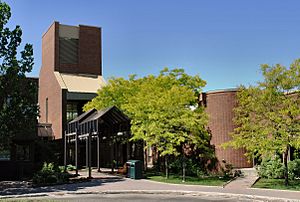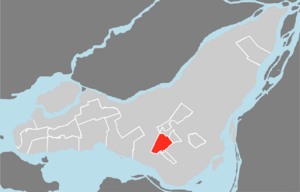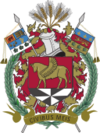Côte Saint-Luc facts for kids
Quick facts for kids
Côte Saint-Luc
|
|||
|---|---|---|---|
|
City
|
|||
| City of Côte Saint-Luc | |||

City hall
|
|||
|
|||
| Motto(s):
Civibus Meis ("For My Citizens")
|
|||

Location of Côte Saint-Luc on the Island of Montreal
|
|||
| Country | Canada | ||
| Province | Quebec | ||
| Region | Montréal | ||
| Village | April 25, 1903 | ||
| Town | December 9, 1951 | ||
| City | February 14, 1958 | ||
| Electoral Districts Federal |
Mount Royal |
||
| Provincial | D'Arcy-McGee | ||
| Area | |||
| • Land | 7.04 km2 (2.72 sq mi) | ||
| Population
(2021)
|
|||
| • Total | 34,504 | ||
| • Density | 4,903.7/km2 (12,701/sq mi) | ||
| • Pop. 2016-2021 | |||
| • Dwellings | 15,548 | ||
| Demonym(s) | Côte Saint-Lucer | ||
| Time zone | UTC-5 (Eastern (EST)) | ||
| • Summer (DST) | UTC-4 (EDT) | ||
| Postal code(s) |
H4V, H4W, H4X
|
||
| Area code(s) | (514) and (438) | ||
Côte Saint-Luc (pronounced "coat san look") is a city in Quebec, Canada. It's located on the Island of Montreal and is mostly a place where people live. It's like a small town completely surrounded by the bigger city of Montreal. Many people here speak English, and there's a large Jewish community.
Contents
Exploring Côte Saint-Luc's Location
Côte Saint-Luc is special because it's an "enclave" within the city of Montreal. This means it's a separate city, but it's entirely surrounded by Montreal.
Unique Parts of the City
Côte Saint-Luc also has two smaller parts that are separate from its main area. These parts are nestled between two other cities, Hampstead and Montreal West.
- The larger separate part has homes and the Decarie Square Mall.
- The smaller part has about fifteen apartment buildings along Macdonald Avenue.
Railroad Area
About one-third of Côte Saint-Luc's land is taken up by Canadian Pacific train yards.
A Look at Côte Saint-Luc's History
The area where Côte Saint-Luc is today was first settled in the 1700s. It officially became a village in 1903. The city's name might be a tribute to an 18th-century military officer named Luc de la Corne Saint-Luc.
Growing as a Community
During the 1920s, the town grew quickly. Many immigrant families moved here from Montreal, especially German-Jewish and British families. Train lines and factories were moved to the northern part of the city. For example, an old farmhouse near Westminster and Côte Saint-Luc is now a shopping area.
From Farms to City Life
Côte Saint-Luc remained a small farming community until the mid-1900s. But after World War II, many people moved here. The population jumped from 747 residents in 1940 to over 20,000 by the mid-1960s. It officially became a town in 1951 and then a city in 1958.
Becoming Independent Again
On January 1, 2002, Côte Saint-Luc was combined with Montreal. It joined with its neighbors, Hampstead and Montreal West, to form a larger borough. However, in 2004, the people of Côte Saint-Luc voted to become a separate city again. So, on January 1, 2006, Côte Saint-Luc was re-established as its own city.
Who Lives in Côte Saint-Luc?
Côte Saint-Luc is known for being a bilingual city since 2005. This means both English and French are important languages here.
Population Growth
In 2021, the city had 34,504 people living there. This was a 6.3% increase from its population in 2016.
Languages Spoken
In 2016, most people in Côte Saint-Luc spoke English at home (60%). About 17% spoke French, and 23% spoke other languages. When it comes to their mother tongue (the first language they learned), 42% spoke English, 20% spoke French, and 38% spoke other languages.
Jewish Community
Côte Saint-Luc has a very large Jewish community. Outside of Israel, it has one of the highest percentages of Jewish people compared to its total population, with 69.1% of residents being Jewish.
City Services and Schools
Côte Saint-Luc offers many services to its residents.
Keeping the City Safe
The city has a full-time Public Security Department that helps enforce local rules. In 2006, they started a program called Volunteer Citizens on Patrol (vCOP). This program allows residents to help prevent crime in their neighborhoods.
Emergency Medical Services
Côte Saint-Luc also has a unique volunteer Emergency Medical Services (EMS) system. This team is usually the first to respond to medical emergencies, handling over 3,000 calls each year. More advanced medical care and rides to hospitals are provided by Urgences-santé. The city worked hard to keep its volunteer EMS system, even when there were plans to replace it.
The Public Library
The city's library is called the Eleanor London Côte Saint-Luc Public Library. It's named after Eleanor London, who was the chief librarian for 36 years. This library is special because it's one of the few in North America that is open every single day of the year!
Shopping and Development
The Cavendish Mall used to be a very important shopping center in the city. It had big stores like Steinberg's and Eaton's. In recent years, parts of the mall have been redeveloped. Now, you can find single-family homes, townhouses, and apartment buildings where some of the mall used to be.
Schools in the City
Côte Saint-Luc has several schools for different age groups.
- The Commission scolaire Marguerite-Bourgeoys operates two French elementary schools: École de la Mosaïque and École des Amis-du-Monde.
- The English Montreal School Board runs a French immersion school called Merton School. They also operate John Grant and Mountainview High Schools, and the Marymount Adult Centre.
- There are also private schools in the city, such as JPPS–Bialik, Hebrew Academy, École Maïmonide, and Yeshiva Yavne.
Famous People from Côte Saint-Luc
Many interesting people have lived in Côte Saint-Luc, including:
- Irwin Cotler: A politician and lawyer.
- William Shatner: A famous actor.
- Irving Layton: A well-known poet.
- Gary Carter: An all-star catcher for the Montreal Expos baseball team.
- Ricky Blitt: A comedy screenwriter.
- Barry Blitt: A magazine illustrator.
- Gordon Korman: A popular author.
- Steven Pinker: A well-known science author and psychologist.
See also
 In Spanish: Côte-Saint-Luc para niños
In Spanish: Côte-Saint-Luc para niños



